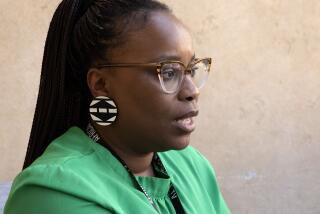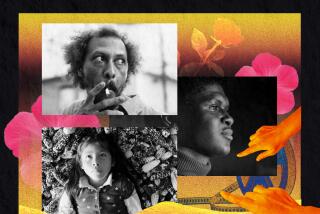UCSD Film Fest Snares Top Flicks : Cinema: University’s International Style Film Festival has grown in stature, attracting films that might not otherwise be seen in San Diego.
- Share via
SAN DIEGO — Steven Rothenberg, senior vice president of theatrical distribution for Samuel Goldwyn Co., concedes to a certain wariness about sending films to film festivals organized by universities. Far too often, the festivals are disorganized and only serve to detract from the films’ audiences when they subsequently open in theaters.
However, Samuel Goldwyn Co. has become a regular contributor to UC San Diego’s annual International Style Film Festival.
Last year, Rothenberg allowed the festival to present the San Diego premiere of Goldwyn’s much-discussed “La Femme Nikita,” and in early January, for its season opener, Rothenberg gave the festival the local premiere of “Mississippi Masala,” Mira Nair’s piece about cross-cultural relationships starring Denzel Washington, which won’t open at the local Landmark Theaters until Feb. 14.
“There is no major festival in San Diego, and therefore the university festival takes on more cachet,” Rothenberg said.
The 7-year-old festival is indeed the only large festival in San Diego spotlighting international films, from those with some “buzz,” as they say in the industry, like “La Femme Nikita,” to obscure works from Taiwan, China and New Zealand. This year’s festival, which opened Jan. 14, continues to present films almost weekly through May 19. Thirteen films are now on the schedule--all San Diego premieres--and three more may be added, according to event organizer Ruth Baily.
Tonight at 8 p.m. in UCSD’s Mandeville Auditorium, Jon Jost’s “All the Vermeers in New York” will screen, a film that follows a French actress and a Wall Street broker through New York’s art and financial worlds.
Although it once bore the burden of being a “university film festival,” International Style has clearly turned an important corner, in terms of prestige and respect within the industry.
“La Femme Nikita” was the first major studio film the festival was able to screen, and it clearly has broken down some barriers.
“This year we’ve had American distributors contacting us,” said Baily, who is not quite sure what happened to change distributors’ attitudes toward the festival.
“It’s part of the evolutionary process of surviving,” she suggested.
In the past, distributors were wary of giving the festival big films for fear of alienating Landmark Theaters, which has a virtual monopoly locally on the art film market, Baily said. Samuel Goldwyn Co. is a sister company to Landmark Theaters--which will subsequently screen many of the big-name films presented by the festival--but Rothenberg said Landmark has never been a factor in deciding what to send.
“We do not operate in a vacuum, we always get feedback from the exhibitors in the marketplace,” Rothenberg said, noting that Landmark officials have never complained about his decisions to send films to the festival.
“The sense I get is that (International Style) is a way to get word percolating about a film with people who are opinion makers and trendsetters,” he said. “It doesn’t take any glamour or luster away from an opening. It helps.”
That’s how New Line Cinema views the festival. New Line has given the festival the San Diego premiere of Stephen King’s “The Lawnmower Man,” the much-discussed film about “virtual reality” starring Pierce Brosnan, the first time New Line has given the festival a film. It is scheduled to be shown Feb. 25.
“Friends of mine have gone the last couple of years and said it was a good place to see a film,” said Alan Amman, vice president of field publicity and promotion for New Line, who used to live in San Diego. “It’s good that San Diego has this type of festival.”
Outside of the respect of film distributors, the festival has become a major player in the local film community, bringing films to San Diego that wouldn’t otherwise make it to the area. Duncan Shepherd of the Reader included two films from last year’s festival in his (very) short list of best films of 1991; Claude Lelouch’s “There are Days . . . and Moons” and Hou Hsiao-hsien’s “A City of Sadness.” Both films played for one night at the festival and never returned to San Diego.
“Ruth (Baily) does a great job,” said Greg Kahn, film curator at the San Diego Museum of Contemporary Art, who particularly enjoys the obscurity of many of the films, including the rare films from Asia. “They’re not offering run-of-the-mill films, or films that come to the Landmark Theaters, and I appreciate that.”
Finding those quality films is the biggest challenge for Baily and Cindy Bellai, the student who helps her put together the event. Baily graduated from UCSD in 1979 and has been working for the university events department ever since. Her only goal with this project is to develop as broad a representation of the world’s films as possible. The search for films becomes a combination of detective work and hard-core negotiating.
Each year, Baily starts the process by sending out a mailer to various embassies requesting information about films from that country. From there, they must learn what films are available and within the reach of the university’s budget, usually about $9,000 a year. The university pays for many films, usually the best known, but many are donated.
Finding prints of many of the films, which are often rare and difficult to locate, is one of Baily’s most difficult tasks. Once prints are found, it is usually necessary to persuade the distributor that it would be worth sending to San Diego--to a university film festival. For example, it took more than a year of dealing with various Japanese interests and then a snippy French distributor to get Kaizo Hayashi’s “Circus Boys,” which screened earlier this year.
“I run into the attitude that San Diego is provincial and nobody will go to the films,” Baily said. “I don’t think San Diego is that provincial.”
In addition to having the built-in on-campus audience, Baily and her colleagues make a concerted effort to interact with the ethnic communities in San Diego. For example, they send out mailers and flyers to make sure the Chinese community is aware of the Chinese films. Churches and social groups are often targeted.
“For a Turkish film last year, we discovered a population we never knew existed in San Diego,” Baily said. “It’s amazing. Word gets out, and I’m not sure how we do it sometimes.”
The efforts have paid off. After several years in the Price Center, they moved into the larger 750-seat Mandeville Auditorium last year. Although the festivals often operate at a deficit, last year’s event lost only $156 and attracted about 7,500 people.
The screenings tend to have a more laid-back atmosphere than most movie houses, with free cookies offered up by a local cookie maker. An information sheet about the films are provided to the audience at each screening.
Since few of the films are well-known, the festival’s success could be taken as testimony that San Diego is, at the very least, an educated and growing film community.
“I know there is a good audience for foreign films,” Baily said. “When we get 750 people at a time, and we have to turn people away, that is really heartening.”
Baily is adamant about keeping the festival non-competitive, even though giving out awards often increases the visibility and stature of a festival, as well as making it easier to get some films. But it would take too long to achieve enough prominence to compete with the established festivals, Baily said, and she prefers to focus more on education and presenting films that are unusual and difficult to see.
A fledgling community group called Friends of International Style has only 10 members now, but Baily hopes it will eventually generate enough interest and money to finance workshops and visits from directors and artists.
“If we establish a profile that combines movies that San Diegans have never been able to see with an education format, we will be able to separate ourselves from other festivals,” Baily said.
The International Style film festival 1992 continues with “All the Vermeers in New York” (USA), tonight; “Te Rua” (New Zealand), Feb. 11; “The Lawnmower Man” (USA), Feb. 25; “Black Snow” (China), March 24; “Red Dust” (Hong Kong), March 31; “Silent Scream” (England), April 7; “Five Girls and a Rope” (Taiwan), April 14; “Samsara” (China), April 21; “Zipang” (Japan), April 28; “Cabeza de Vaca” (tentative), May 19. All screenings are at 8 p.m. in the Mandeville Auditorium on the UCSD campus. Single tickets are $4 for students, $5 general admission. Tickets and information are available from the UCSD box office, 534-6467.
More to Read
Only good movies
Get the Indie Focus newsletter, Mark Olsen's weekly guide to the world of cinema.
You may occasionally receive promotional content from the Los Angeles Times.










